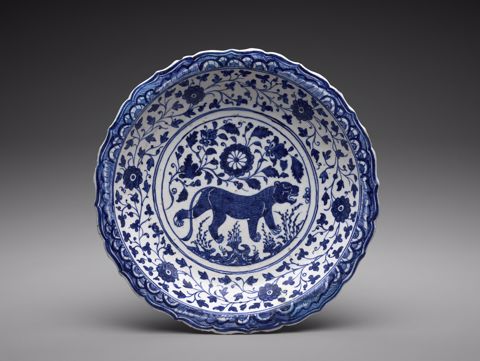Rare Works of Persian Blue and White Ceramics from the Hossein Afshar Collection on View Together for the First Time

Dish, Persian, Timurid or early Safavid, second half of 15th century, stonepaste; painted in blue on white slip under transparent glaze, the Hossein Afshar Collection at the Museum of Fine Arts, Houston.
The Museum of Fine Arts, Houston, explores the enduring appeal of blue and white ceramics from around the globe in Between Sea and Sky: Blue and White Ceramics from Persia and Beyond
HOUSTON—The Museum of Fine Arts, Houston, tells the story of the enduring, worldwide appeal of blue and white ceramics through the exhibition Between Sea and Sky: Blue and White Ceramics from Persia and Beyond. This exhibition brings together 74 works, including selections from the exceptional Hossein Afshar Collection of Persian art on long-term loan to the MFAH, offering a new understanding of Persian blue and white’s monumental contribution to the world history of ceramics. Between Sea and Sky is on view through Monday, May 31.
“We have an extraordinary opportunity to examine the ongoing allure of blue and white ceramics through one of the most significant collections of Persian art,” said Gary Tinterow, director, the Margaret Alkek Williams Chair, the Museum of Fine Arts, Houston. “Following our 2017 debut of Hossein Afshar’s collection in the exhibition Bestowing Beauty: Masterpieces from Persian Lands, we are delighted to share important, never-before-seen examples from the spectacular collection with our visitors.”
“It is our hope that these extraordinary Persian ceramics will shed light on a new and more nuanced understanding of the many complex layers of technical and artistic exchange between Persia and China and the significant contribution of Persian blue and white ceramics to the world history of ceramics,” said Aimée Froom, curator, Islamic art. “To be able to display these ceramics alongside the Museum’s global collections of blue and white ceramics for the first time is an added feast for the eyes.”
Exhibition Overview
Between Sea and Sky opens with the early trade history of ceramics, when cobalt blue from the Persian Gulf meets ceramic shapes and techniques from China. The story continues with the introduction of stonepaste, which revolutionized Persian ceramics and spawned an unprecedented flourishing of shapes, techniques, and colored glazes in the 11th to the 14th century—an area in which the Hossein Afshar Collection is particularly rich. Rare Persian blues also played a significant role, ranging from the luxurious and rare lapis lazuli (lajvardina) and turquoise (firouzeh) to brilliant cobalt, which adorn Persian ceramics, architectural tiles, glass, jewelry, and manuscripts. Locally mined and traded across Islamic lands and the world, rare Persian blues were as precious as gold.
Chinese blue and white porcelain was highly prized and collected by the Islamic courts in Iran, Turkey, and India. The exhibition features three outstanding examples on loan from the San Antonio Museum of Art, including an extraordinary dish inscribed with the name of the Mughal Emperor Shah Jahan (reigned 1528–58). A section titled “Inspired by China” highlights the creative synthesis seen in 15th– to 17th–century Persian ceramics, which combine Chinese dragons and other motifs with Persian blues, shapes, and decorative motifs. Chinese blue and white porcelain was also coveted and collected across Asia and Europe to the shores of England, inspiring local production along the way.
Joining the exquisite works from the Hossein Afshar Collection are iconic blue and white objects from the MFAH collections, on view together for the first time. Demonstrating the many different cultural resonances of this wide-ranging tradition are selections of blue and white English porcelain and delftware from the Rienzi and Bayou Bend collections; notable Japanese Arita ware from the Sarah Campbell Blaffer Foundation; and important examples of global contemporary blue and white ceramics.
About the Museum of Fine Arts, Houston
Established in 1900, the Museum of Fine Arts, Houston, is among the 10 largest art museums in the United States, with an encyclopedic collection of nearly 70,000 works dating from antiquity to the present. The Museum’s Susan and Fayez S. Sarofim main campus comprises the Nancy and Rich Kinder Building, designed by Steven Holl Architects and opened in 2020; the Audrey Jones Beck Building, designed by Rafael Moneo and opened in 2000; the Caroline Wiess Law Building, originally designed by William Ward Watkin, with extensions by Ludwig Mies van der Rohe completed in 1958 and 1974; the Lillie and Hugh Roy Cullen Sculpture Garden, designed by Isamu Noguchi and opened in 1986; the Glassell School of Art, designed by Steven Holl Architects and opened in 2018; and The Brown Foundation, Inc. Plaza, designed by Deborah Nevins & Associates and opened in 2018. Additional spaces include a repertory cinema, two libraries, public archives, and facilities for conservation and storage. Nearby, two house museums—Bayou Bend Collection and Gardens, and Rienzi—present American and European decorative arts. The MFAH is also home to the International Center for the Arts of the Americas (ICAA), a leading research institute for 20th-century Latin American and Latino art. mfah.org
Organization and Funding
This exhibition is organized by the Museum of Fine Arts, Houston.
Media Contact
Katie Jernigan, senior publicist
kjernigan@mfah.org | 713.639.7516
